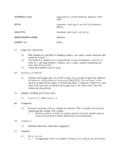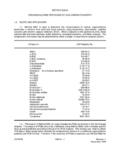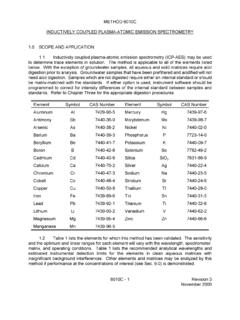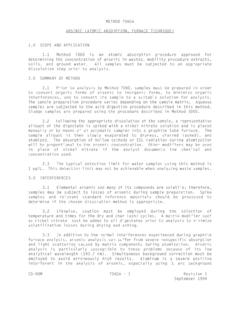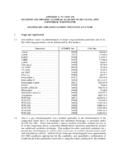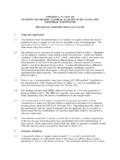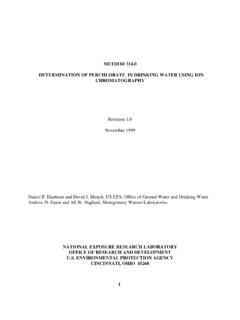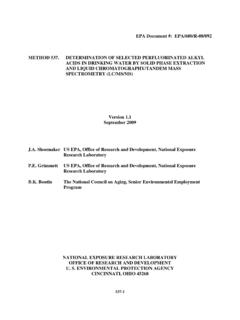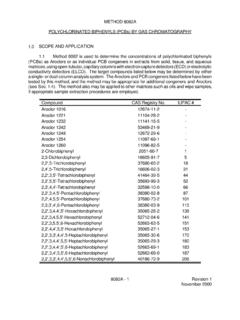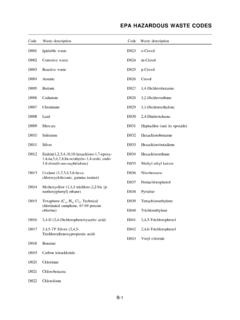Transcription of METHOD 8015B NONHALOGENATED ORGANICS …
1 CD-ROM8015B - 1 Revision 2 December 1996 METHOD 8015 BNONHALOGENATED ORGANICS using AND 8015 is used to determine the concentration of various NONHALOGENATED volatileorganic compounds and semivolatile organic compounds by gas chromatography. The followingcompounds can be determined quantitatively by this METHOD : Appropriate Technique Compound NamePurge-and-Direct Solvent CAS aAcetone67-64-1pp b,d IAcetonitrile75-05-8pp b,d IAcrolein107-02-8pp b,d IAcrylonitrile107-13-1pp b,d IAllyl alcohol107-18-6ht b,d I1-Butanol (n-Butyl alcohol)71-36-3ht b,d It-Butyl alcohol75-65-0pp b,d I2-Chloroacrylonitrile ( )920-37-6NA d NACrotonaldehyde123-73-9pp b,d IDiethyl ether60-29-7 b b I1,4-Dioxane123-91-1pp b,d IEthanol64-17-5 I b,d IEthyl acetate141-78-6 I b,d IEthylene glycol107-21-1 I b IEthylene oxide75-21-8 I b,d IHexafluoro-2-propanol ( )920-66-1NA d NAHexafluoro-2-methyl-2-propanol ( )
2 515-14-6NA d NAIsobutyl alcohol78-83-1pp b,d IIsopropyl alcohol67-63-0pp b,d IMethanol67-56-1 I b,d IMethyl ethyl ketone (MEK)78-93-3pp b,d IMethyl isobutyl ketone (MIBK)108-10-1pp b,d IN-Nitroso-di-n-butylamine924-16-3pp b,d bParaldehyde123-63-7pp b,d I2-Pentanone107-87-9pp b,d I2-Picoline109-06-8pp b,d I1-Propanol71-23-8pp b,d IPropionitrile107-12-0ht d ICD-ROM8015B - 2 Revision 2 December 1996 Appropriate Technique Compound NamePurge-and-Direct Solvent CAS aPyridine110-86-1 I b,d bo-Toluidine95-53-4 I b,d b Chemical Abstract Services Registry bAdequate response using this technique dAmenable to concentration by azeotropic distillation ( METHOD 5031) htMethod analyte only when purged at 80EC IInappropriate technique for this analyte ppPoor purging efficiency, resulting in high EQLs NANot standard appropriate for METHOD METHOD may also be applicable to the analysis of petroleum hydrocarbons, includinggasoline range ORGANICS (GROs) and diesel range ORGANICS (DROs).
3 GROs correspond to the rangeof alkanes from C to C and covering a boiling point range of approximately 60EC - 170EC6 10(Reference 6). DROs correspond to the range of alkanes from C to C and covering a boiling point10 28range of approximately 170EC - 430EC (Reference 6). The identification of specific fuel types maybe complicated by environmental processes such as evaporation, biodegradation, or when morethan one fuel type is present. methods from other sources may be more appropriate for GROs andDROs, since these hydrocarbons are not regulated under RCRA. Consult State and local regulatoryauthorities for specific METHOD is restricted for use by, or under the supervision of, analysts experiencedin the use of gas chromatographs and skilled in the interpretation of gas chromatograms.
4 In addition,if this METHOD is used for the analysis of petroleum hydrocarbons, it is limited to analysts experiencedin the interpretation of hydrocarbon data. Each analyst must demonstrate the ability to generateacceptable results with this METHOD can also be used as a screening tool (for both volatile and semivolatileorganics) to obtain semiquantitative data for the prevention of sample overload during quantitativeanalysis on a GC/MS system. This may be accomplished using an automated ( METHOD 5021)headspace METHOD or by direct injection if a solvent extraction METHOD has been utilized for samplepreparation. Single point calibration would be acceptable in this situation. Performance data arenot provided for OF 8015 provides gas chromatographic conditions for the detection of certainnonhalogenated volatile and semivolatile organic may be introduced into the GC:@following solvent extraction ( methods 3510, 3520, 3540, 3541, 3545, 3550, or3560)CD-ROM8015B - 3 Revision 2 December 1996@by direct injection (aqueous samples) including the concentration of analytes byazeotropic distillation ( METHOD 5031)@by purge-and-trap ( methods 5030 or 5035), or@by vacuum distillation ( METHOD 5032) or surface water samples must generally be analyzed in conjunction withMethods 5030, 5031, 5032, 3510, 3520, or other appropriate preparatory methods to obtainthe necessary quantitation limits.
5 METHOD 3535 (solid-phase extraction) may also be applicableto the target analytes, but has not yet been validated by EPA in conjunction with METHOD range ORGANICS (DROs) may be prepared by an appropriate solventextraction range ORGANICS (GROs) may be introduced into the GC/FID by purge-and-trap, automated headspace, vacuum distillation, or other appropriate appropriate column and temperature program is used in the gas chromatograph toseparate the organic compounds. Detection is achieved by a flame ionization detector (FID). METHOD allows the use of packed or capillary columns for the analysis andconfirmation of the non-halogenated individual analytes. Columns and conditions listed have beendemonstrated to provide separation of those target analytes.
6 Analysts may change these conditionsas long as they demonstrate adequate performance. silica capillary columns are necessary for the analysis of petroleum analyzing for volatile ORGANICS , samples can be contaminated by diffusion of volatileorganics (particularly chlorofluorocarbons and methylene chloride) through the sample containerseptum during shipment and storage. A trip blank prepared from organic -free reagent water andcarried through sampling and subsequent storage and handling must serve as a check on by carryover can occur whenever high-concentration andlow-concentration samples are analyzed in sequence. To reduce the potential for carryover, thesample syringe or purging device must be rinsed out between samples with an appropriate an unusually concentrated sample is encountered, it should be followed by injection ofa solvent blank to check for cross purging vessels with a detergent solution, rinse with distilled water, andthen dry in a 105EC oven between analyses.
7 Clean syringes or autosamplers by flushing allsurfaces that contact samples using appropriate glassware must be scrupulously cleaned. Clean all glassware as soon aspossible after use by rinsing with the last solvent used. This should be followed by detergentwashing with hot water, and rinses with tap water and organic -free reagent water. Drain theglassware and dry in an oven at 130EC for several hours or rinse with methanol and dry glassware in a clean - 4 Revision 2 December flame ionization detector (FID) is a non-selective detector. There is a potential formany non-target compounds present in samples to interfere with this AND Chromatograph - Analytical system complete with gas chromatographsuitable for solvent injections or purge-and-trap sample introduction and all requiredaccessories, including detectors, column supplies, recorder, gases, and syringes.
8 A datasystem for measuring peak heights and/or peak areas is GC 1 - 8 ft x in. ID stainless steel or glass column packed with1% SP-1000 on Carbopack-B 60/80 mesh or 2 - 6 ft x in. ID stainless steel or glass column packed withn-octane on Porasil-C 100/120 mesh (Durapak) or 3 - 30 m x mm ID fused silica capillary column bonded withDB-Wax (or equivalent), 1- m film 4 - 30 m x mm ID fused silica capillary column chemicallybonded with 5% methyl silicone (DB-5, SPB-5, RTx, or equivalent), m film columns are needed for petroleum hydrocarbonanalyses. Laboratories may use other capillary columns ( mm IDcapillary columns) if they document METHOD performance data ( resolution and MDLs) if appropriate for the intended use of columns should be installed in 1/4-inchinjectors, with deactivated liners designed specifically for use with these - Flame ionization (FID) introduction and preparation apparatus to the 5000 series sample preparation methods for the may also be introduced into the GC via injection of solvent extracts ordirect injection of aqueous 5-mL Luer-Lok glass hypodermic and a 5-mL gas-tight syringe with shutoffvalve for volatile - 5 Revision 2 December - 10- and 25- L with a in.
9 ID needle (Hamilton 702N orequivalent) and 100- flasks, Class A - Appropriate sizes with ground glass balance - 0 - 160 g capacity, capable of measuring differences of grade chemicals shall be used whenever possible. Unless otherwise indicated,it is intended that all reagents shall conform to the specifications of the Committee on AnalyticalReagents of the American Chemical Society, where such specifications are available. Other gradesmay be used, provided it is first ascertained that the reagent is of sufficiently high purity to permit itsuse without lessening the accuracy of the reagent water - All references to water in this METHOD refer to organic -freereagent water, as defined in Chapter , CHOH. Pesticide quality or equivalent. Store away from other , , gasoline or diesel.
10 Purchase from a commercial source. Low boilingcomponents in fuel evaporate quickly. If available, obtain fuel from the leaking tank on standard. A standard containing a homologous series of n-alkanes forestablishing retention times ( , C-C for diesel). standards - Stock solutions may be prepared from pure standard materials orpurchased as certified solutions. When methanol is a target analyte or when using azeotropicdistillation for sample preparation, standards should not be prepared in methanol. Standards mustbe replaced after 6 months or sooner, if comparison with check standards indicates a dilution standards - using stock standard solutions, prepare secondary dilutionstandards, as needed, that contain the compounds of interest, either singly or mixed together.
